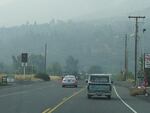
Driving into Ashland, Oregon, the hills are shrouded in wildfire smoke.
Jes Burns / OPB
Oregon Gov. Kate Brown is calling for a major expansion in the state’s wildfire response plans in a new legislative concept lawmakers heard on Tuesday.
The draft proposal outlines the governor's long-term vision for how the state should adapt to wildfire, reduce wildfire risks on forestland and improve fire suppression.
The plan echoes a 110-page report from the Governor's Council On Wildfire Response, which spent about a year developing recommendations for improving the state's ability to prevent and respond to wildfires.
It calls for land-use planning changes, new building codes and requirements for "defensible space" around homes to reduce the risk of wildfires damaging residential areas. It requires new standards for residential smoke filtration systems to protect people from the health risks of wildfire smoke.
It adds new jobs in the Office of Emergency Management that would be designed to handle wildfire emergencies, and it sets a goal of “treating” 300,000 acres of forestland a year to reduce wildfire fuel through logging, controlled burning and ecosystem restoration projects.
Related: Why Many Northwest Animals And Plants Need Wildfire
Over the next 20 years, the governor wants to see similar treatment on 5.6 million acres of forestland across the state, which her wildfire council estimated would cost about $4 billion in a report released in November.
The legislative draft calls for a study of how the state might pay for wildfire preparedness and suppression. It does not include any dollar figures for how much money should be appropriated to pay for legislative requirements, leaving lawmakers to determine later what parts of the bill would actually receive funding.
Jason Miner, Gov. Brown's natural resources policy manager, outlined the broad strokes of the bill for lawmakers in the Senate Interim Committee on Wildfire Prevention and Recovery. He said the governor is open to discussion and amendments to her proposal.
Committee member Herman Baertschiger, R-Grants Pass, said wildfire risk is so immense that the governor’s proposal will barely begin to address it.
“When you look at how big the problem is and what you’re proposing here — even at 300,000 acres a year — it’s like mowing your grass with a tweezers,” he said. "Everybody needs to know how big this problem is. It is big. It is huge. And how we’re going to pay for it, I have no idea.”
Sen. Baertschiger told Miner and other members of the governor’s wildfire council that the plan will have to produce its own revenue through logging because lawmakers are facing demands for funding to help with major problems with foster care, mental healthcare and homelessness as well as the need to fund Medicaid and the Public Employee Retirement System.
“Those are the dollars you’re competing with,” he said. “We have to produce some commodities to pay for this. You can’t run to the general fund for the dollars. We need them somewhere else.”
Critics of the governor’s proposal warned the committee to focus its spending on measures that have proven to be effective in reducing wildfire risks and avoid logging in back-country areas where wildfire could be beneficial and there aren’t any homes in need of protection.
“Scientists have found that thinning forests far from homes does nothing to protect Oregonians from wildfire,” Lluvia Merello, energy justice organizer for Oregon Physicians for Social Responsibility, said. “Ironically, thinning forests to reduce wildfire risk releases more carbon than the fire itself.”
Merello and others with conservation groups told the committee the most important changes will be the ones that make homes and communities more resilient to wildfire in the future.
Samantha Crop with Cascadia Wildlands said many of the fuel reduction logging projects she’s seen on federal land involve opening the forest canopy with clear-cuts that remove medium and large trees that would typically be resistant to fire, compacting the soil and drying out the forest.
“So-called fire reduction proposals that I’m seeing in practice look like just the same old commercial logging and clear-cut style practices with a fire or fuel rationale tacked onto them,” she said.
“I think it’s really important for us to be really skeptical of these so-called fire reduction logging projects.”
The governor’s wildfire council created a prioritized list of forest thinning and burning projects that are ready to go and have already gone through environmental reviews. How many of those projects get accomplished in the next year will likely depend on how much funding lawmakers allocate to that portion of the proposed bill.
Sen. Lew Frederick said the funding question is a big one, but he wants the state to do what it can to address wildfire risks with the funding it can muster.
“Everybody wants somebody else to pay for it and that’s simply not going to be available,” the Portland Democrat said.
“We’re not going to be harvesting the way we were in the '70s and '80s. We’re not going to be stopping everything from happening in the forest the way some folks would like to have happen. We have to find a balance and this is an attempt at a balance.”
